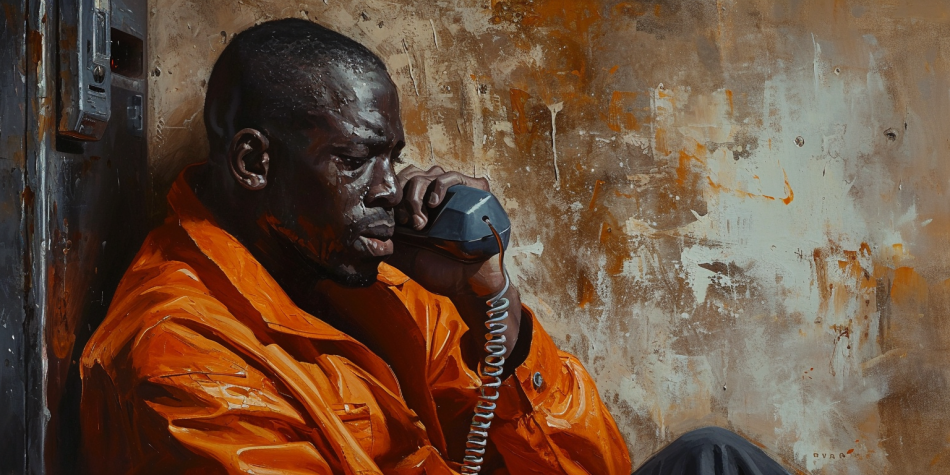Growing up, I learned the simple story that my mother was born to a teenage mother who couldn’t keep her. That’s sad but easy to understand—who could blame a 16-year-old girl for giving her child up for adoption?
Later, I learned that my biological grandmother had been a drug addict who couldn’t cope with motherhood. Even sadder but still a fairly simple story.
Only recently have I learned that the life of this grandmother-I-never-knew is also a story of the violence and abuse produced by racism and sexism—a reminder that our individual histories can’t be understood separate from the cruel, oppressive forces that shape society.
But this fuller picture of my family, which I have pieced together from my prison cell, also has reminded me that beautiful things can be born through something broken.
Let’s go back to that simple story.
My mother, Rebekah Patrice Davis, was raised by her adoptive mother, Geraldine Davis, who was a loving and kind Black woman. (Mom’s adoptive father died when she was very young.) My mom always yearned for a relationship with the family she was born into but was plagued by the thought that maybe her biological mother really didn’t want her. This fear of rejection, along with difficulty finding information about her birth family, discouraged her from trying to identify and contact her mother. Beautiful things can be born through something broken.
But it didn’t end there. The case worker gave her four telephone numbers that possibly belonged to relatives. No one picked up at the first two numbers, but the third call was answered by a man named Ronnie. My mother hesitantly explained who she was, and her half-sibling abruptly interjected, “I’m your brother and Mom never wanted to give you away!”
That was the beginning of the end of the simple story.
Seven years later, I sat on the edge of my steel bunk, staring at the old photo of my biological grandmother that my mother had sent me. My grandmother’s long ember-colored hair flowed over her shoulders and rested on her back as she sat on the sidewalk, holding a 4-year-old who I would learn was my Uncle Marcus, another of my mother’s four half-siblings whom I had known nothing about. I had been incarcerated for nearly 15 years, and this was my first encounter with these relatives, through a photo that came in a large manila envelope to my prison cell.
To sum up the simple story, my mother always knew she had been adopted at birth and believed that it was because her mother was too young to provide for her child. After talking with her half-siblings, she assumed that her mother’s drug problem was also a factor. But when I started talking with my newfound aunt and uncle, that story of how racism and sexism fueled the abuse and violence that shaped my grandmother’s life emerged. Should I have been surprised? These forces run deep in American history, of course, but we don’t always realize how powerful are the corrosive effects on individuals in our lives.
I ran my fingers lightly across the photo, fascinated by the striking resemblance between my mother and grandmother. The brim of their noses, almond-shaped eyes, rosy cheeks, and thin lips made them look nearly identical. The only exception was that my grandmother was White, and my mother was Black.
I set the picture of my grandmother on the gray steel table next to the prison phone and dialed my Aunt Rhonda’s number. My mother had given me contact information for Rhonda and Ronnie, who could help me learn more about our family history. As the phone rang, I took a deep breath to relieve my nervousness. I didn’t know what to expect from this initial conversation. After my aunt accepted the collect call, we spent a few minutes in small talk before I jumped right into inquiring about the life of Donna Phillips, the woman in the photo whose blood runs through my veins
I wanted to be respectful and began by asking what my grandmother was like—what things she loved to do. The awkwardness that can exist between two strangers was broken when my aunt, in her boisterous voice, said that my grandmother loved Keith Sweat, an R&B singer who released his breakout album in the late 1980s. The two of us began singing “Make It Last Forever,” drawing out the “ever” part melodramatically.

Rhonda told me that her mother/my grandmother really enjoyed music, fashion, and artwork. But above all, Donna felt most alive being outdoors, by the lake, surrounded by trees. My aunt talked about how my grandmother dreamed of living in a house where she could see the mountains from the backyard and wake up to the scent of crisp air and the feel of morning dew on green grass. “These were the things that made her happy,” Rhonda said. “These were the things that put a smile on her face.”
When Rhonda talked about how much my grandmother loved and valued her children, I couldn’t help but wonder: “If her children meant so much to her, why did she give my mother away?” Rhonda began unpacking the traumatic circumstances surrounding my mother’s conception, details that Ronnie also would discuss with me. The information shattered my preconceptions about who my grandmother was, leaving my heart aching over what she was forced to endure as a child. I had too easily accepted the idea that my grandmother had been a selfish.
My great-grandmother apparently agreed with James’ views and didn’t challenge the emotional abandonment, frequent beatings, and sexual abuse that crushed Donna’s childhood spirit in ways hard to imagine.
I could feel the lump form in my throat as I listened to my uncle talk to me in a separate conversation about the numerous times my grandmother was locked in a basement for hours. Apparently, this was her mother and stepfather’s way of disciplining her, either for misbehavior or whenever she became an inconvenience. It wasn’t long before her two stepbrothers began emulating the same abusive behavior. Both boys were physically aggressive toward Donna, and one forced her into a closet and raped her when she was 9 years old.
The more I listened to my aunt and uncle describe my grandmother’s upbringing, the more I realized that I had too easily accepted the idea that my grandmother had been a selfish, irresponsible drug addict. I had failed, out of ignorance, to consider the traumatizing events that she’d experienced before her introduction to drugs. Sadly, this is too often what society trains us to do—define and categorize a person by what we hear and what we see, rarely considering the circumstances that may have shaped them as children.
By the time my grandmother turned 15, she was having sex with multiple men, including Murray Givre, a 22-year-old Jewish man who had Nigerian, Sierra Leonean, and Somali heritage. My grandmother told her family that she had met him in high school, and apparently, no one had been concerned about his age or questioned the story about how they had met. According to my uncle, my grandmother’s stepfather had taken a liking to Murray in spite of James’ atheistic and White-supremacist views. My grandmother’s parents considered him Black and his Jewish heritage didn’t change that. In their eyes, there were no important distinctions between Blacks and Native Americans, Hispanics, and Jews. If you weren’t White, you were Black, plain and simple.
Despite those prejudices, James often invited Murray over to play poker and go fishing on their days off work. Though Murray was a regular visitor to my grandmother’s home, no one suspected that he and my grandmother were sexually involved, even when my grandmother unexpectedly became pregnant.
According to Ronnie, my grandmother’s high school teachers noticed her pregnancy first. My great-grandmother was furious, though her indignation apparently had nothing to do with a 15-year-old getting pregnant but rather that the child might be Black. For my great-grandmother, a Black child being raised in a White home was unacceptable. In the 1960s, these dividing lines between color were societal norms for many White families, not just in the South but also in northern states such as Washington. These prejudices led my great-grandmother to put my grandmother into a home that prepared White girls to give up their babies at birth, typically through adoption. On November 22, 1968, my grandmother gave birth to my mother and returned home without her child, a devastating loss that would dramatically alter her life.
Rhonda emphasized that my grandmother never wanted to give up her baby and that having her daughter pried from her arms left a tremendous hole in her heart, exacerbating my grandmother’s childhood trauma. Donna Phillips teetered on the edge of hopelessness.
My uncle explained that through the chaos, Murray Givre continued to play poker with James Neely and work odd jobs around the house. The Neelys were bent on believing that my grandmother was pregnant by Ronnie Larry, a Black man who later fathered Rhonda and Ronnie. Murray continued his secret sex life with my grandmother, apparently unaware that he was the father of the child my grandmother was forced to give up.
Within two years, my grandmother gave birth to Uncle Ronnie. But by this time, the trauma my grandmother had endured over the years had undermined her ability to mother. As these adverse experiences weighed on her teenage shoulders, she began escaping into drugs, promiscuity, and a criminal lifestyle. Going to jail became a part of her normal routine, which eventually led her to doing time in the penitentiary. Prison is almost never helpful for people dealing with deeply rooted trauma.
After Ronnie was born, my grandmother gave birth to Rhonda, Markus, and Marketta. Although she eventually lost custody of all her kids because of her lifestyle, Ronnie, Rhonda, and Markus had opportunities to visit their mother. Marketta, on the other hand, was taken at 10 months, never to see her mother again except for once when she was 18. And there was other sadness in their lives. According to Rhonda, her and Ronnie’s father was murdered in Seattle in the 1980s, and they grew up without him, while the father of Markus and Marketta was rarely around to help raise his children.
When I asked my aunt about her childhood memories of time with her mother, she responded by saying, “Some days were rough!” She said that my grandmother’s home was a “shooting gallery” where other drug addicts would come and shoot dope. Ronnie, who had been exposed to drugs as a child, eventually began using with my grandmother, developing the same habit and lifestyle.
But Rhonda said that among the nightmarish moments, there also were plenty of positive memories. She recalled how excited she would be to sit by the lake and feed the ducks with her mom. She described a moment when her mother was sick and didn’t have the strength to step outside and watch the fireworks on the 4th of July. So, my aunt fired a few small ones out the window so my grandmother could see them. These were the moments when she and her brothers would feel the love they yearned for. Those experiences of family time brought an occasional semblance of stability into their chaotic world.
My grandmother tried to be a better parent, but my great-grandmother, Mary-Ann, never really supported her. She had practically exiled my grandmother, not only because of her drug problem but because her children were Black. According to Ronnie, the Neelys made it clear that none of my grandmother’s children were welcome in their home, and that’s the way it stayed for much of their lives.
Things began to change for my grandmother when her health deteriorated, and she was diagnosed with Chronic Obstructive Pulmonary Disease. She began to reflect on her choices, reevaluating what was important to her. My aunt said that around this time, my grandmother began expressing interest in God, making frequent comments about Christ and His ability to forgive her for all her transgressions. Ronnie said that in the last three months of her life, she periodically would apologize for the lifestyle she had exposed him to, speaking of her deep regret for the way she had raised her children. She also spoke about my mother, trying to imagine what life would have been like had they not been separated. When my uncle told me about his response to my grandmother’s apologies, I felt his compassion and the ring of truth in his words: “Mom, you did the best you could with what you had.”
Those words resonated deeply with me. Too often, people who are down in life are told to pull themselves up by their bootstraps, even if they have no boots. Now when I think about my grandmother, I account for all the trauma—the loss of her father and brother, being abused and raped as a child, routine mistreatment and abandonment, and then having her daughter pried from her hands because of racist parents. How could she have been better when better was never modeled for her? How could she love properly when she had never been properly loved? We all are, in some ways, limited in what we can do by what we have had done to us. “Mom, you did the best you could with what you had.”
Two weeks after my 21st birthday, I was sentenced to 63 years in prison as an accomplice to first-degree murder and on multiple counts of attempted murder in the second degree. Although I accept accountability for my actions, I cannot ignore the adverse experiences that molded my childhood and adolescent mind. Unfortunately, much of American society ignores these dynamics, choosing only to see incarcerated individuals through the lens of what they have done rather than the social forces that shape the communities they come from.
After my last conversation with Rhonda, I paced the floors in my cell before picking up the photo of my grandmother again. Growing up, my five siblings and I knew nothing about the circumstances surrounding our mother’s conception. We were clueless about the life of our grandmother, including the childhood trauma she experienced. She still chose to live.
Herein is a testimony that no matter what life looks like, there is hope that beautiful things can still be born through something broken.

















